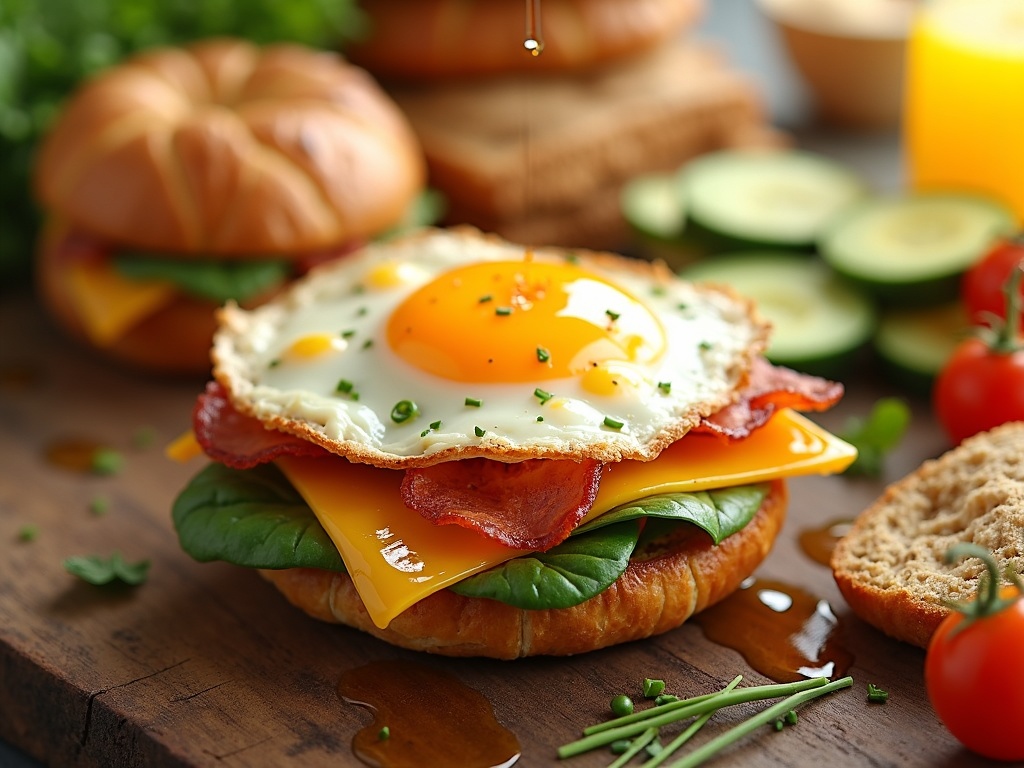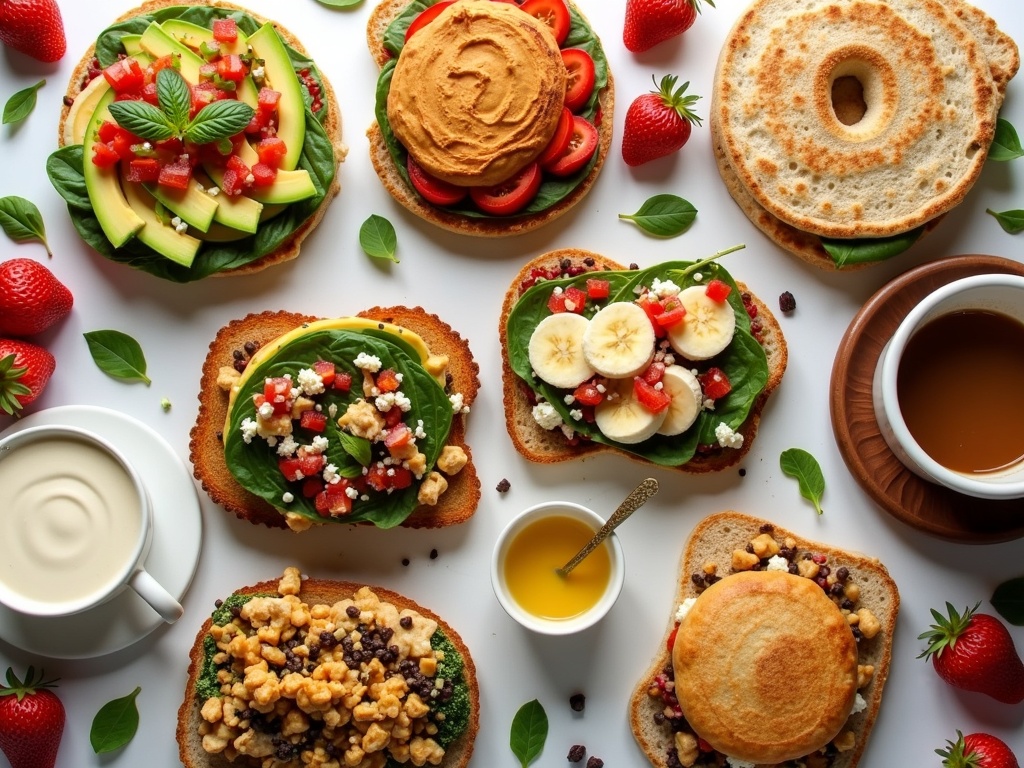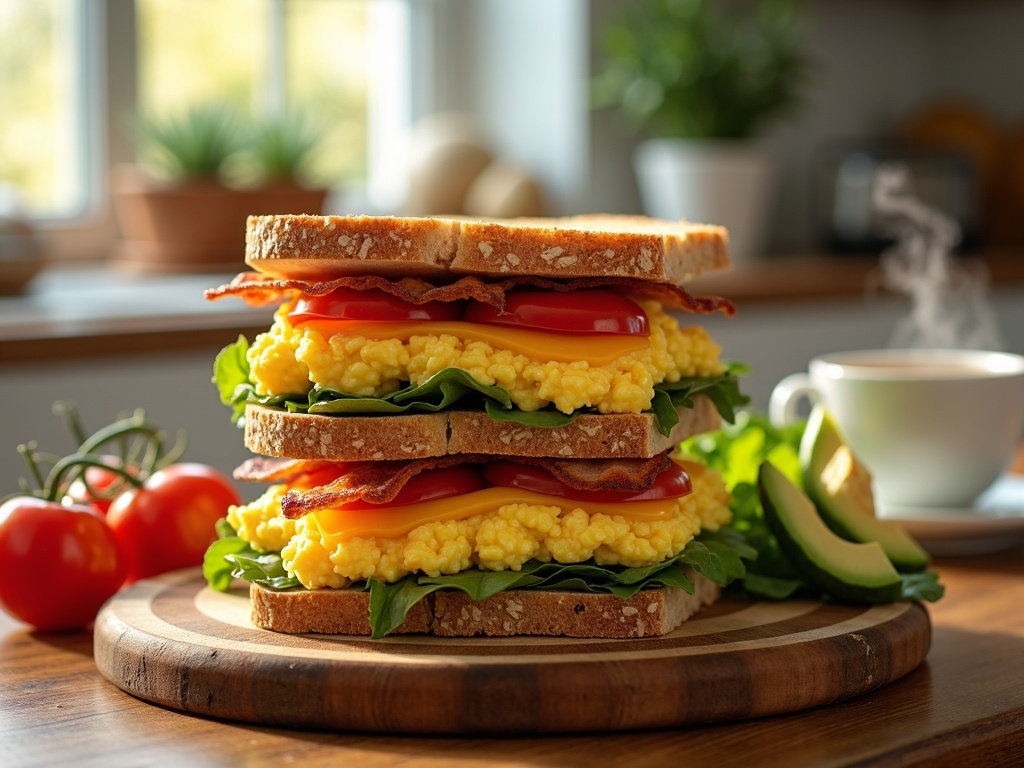The breakfast sandwich dominates America’s morning meal scene, with market projections showing 5.5% annual growth until 2027 and already capturing 20% of the U.S. breakfast food market. This growth demonstrates Americans’ enthusiasm for this handheld option that perfectly combines convenience, nutrition, and customization possibilities.
Find In This Article
Key Takeaways
- A typical homemade breakfast sandwich contains 300-500 calories, providing sustained energy through the morning while being easily customizable for different dietary needs.
- Making breakfast sandwiches at home saves approximately 60-70% compared to purchasing them at cafes or fast-food restaurants.
- The foundation of a great breakfast sandwich starts with the bread choice (whole grain, English muffins, bagels, or croissants) which significantly impacts texture and flavor.
- Proper assembly techniques, including strategic layering and toasting bread to prevent sogginess, are crucial for sandwich structural integrity.
- Breakfast sandwiches can be batch-prepared and frozen for busy mornings, maintaining quality while providing control over ingredients and portions.
Why Breakfast Sandwiches Are Becoming America’s Favorite Morning Meal
The breakfast sandwich has captured American hearts and stomachs in a remarkable way. Looking at the numbers, it’s easy to see why this handheld meal has become a morning staple – the market is projected to grow at 5.5% annually until 2027, with breakfast sandwiches already representing 20% of the U.S. breakfast food market. This impressive growth reflects a fundamental shift in how Americans approach their first meal of the day.
Convenience Meets Nutrition
I’ve noticed more people reaching for breakfast sandwiches because they offer the perfect balance of convenience and nutrition. A typical homemade sandwich contains between 300-500 calories, making it a reasonably portioned morning meal that provides sustained energy. The customizable nature of these sandwiches means you can pack them with protein, whole grains, and even vegetables.
The versatility is unmatched – you can find everything from classic egg and cheese breakfast sandwiches to heartier options with beef bacon or chicken sausage. Vegetarian varieties have gained popularity too, with avocado, plant-based proteins, and roasted vegetables creating satisfying meat-free alternatives.
What makes these sandwiches particularly appealing is their adaptability to different dietary needs without sacrificing taste. I can easily swap out ingredients to make them lower in sodium, higher in protein, or dairy-free depending on specific nutritional goals.
Economic Benefits of DIY Approach
Making breakfast sandwiches at home isn’t just healthier – it’s significantly more economical. Creating these morning meals in your kitchen saves approximately 60-70% compared to purchasing them at cafes or McDonald’s breakfast counters. This dramatic cost difference adds up quickly for regular breakfast eaters.
The financial benefits extend beyond just the immediate savings. With a well-stocked kitchen, I can prepare multiple sandwiches at once, freeze them, and have ready-to-heat breakfasts for busy mornings. This batch-cooking approach maximizes both time and money efficiency.
The restaurant industry has certainly noticed this trend, with chains like Wendy’s breakfast menu and Burger King breakfast offerings expanding their morning sandwich selections. Even Chick-fil-A breakfast has capitalized on this growing demand with their chicken-based morning options.
However, the DIY approach gives me complete control over ingredients, portions, and nutrition – something that’s increasingly important to health-conscious consumers. I can choose whole grain bread instead of white, add extra vegetables, or control sodium levels in ways that restaurant options simply can’t match.
The breakfast sandwich revolution also aligns perfectly with changing American lifestyles. As more people work from home or need portable options for commutes, these handheld meals offer practical solutions to modern eating challenges. They’re more substantial than many traditional breakfast foods like cereal or pastries, providing longer-lasting energy through the morning.
The combination of convenience, nutrition, customization options, and cost savings explains why breakfast sandwiches have moved from occasional indulgence to everyday staple. As cooking techniques and ingredients continue to evolve, I expect these morning marvels to claim an even larger portion of America’s breakfast landscape in the coming years.
Essential Ingredients for the Perfect Breakfast Sandwich
Building the perfect breakfast sandwich starts with selecting quality ingredients that blend well together. I’ve broken down the essential components that will help you craft a delicious morning meal that rivals what you’d find at popular chains like McDonald’s breakfast offerings.
Foundation: Bread Options
The base of your sandwich can make or break the entire experience. I prefer using these options depending on the flavor profile I’m creating:
- Whole grain bread: Perfect for a healthier option with added fiber and nutty flavor
- English muffins: Creates a classic foundation with nooks and crannies that catch all the delicious flavors
- Bagels: Provides a chewy texture and substantial base for heartier sandwich builds
- Croissants: Adds buttery, flaky layers for a more indulgent experience
Each bread option brings its own texture and flavor to complement the fillings. For a quick weekday breakfast, I find English muffins work best, while weekend brunches call for croissants or bagels.
Core Ingredients
The magic of a great breakfast sandwich lies in the perfect combination of protein, fat, and flavor. Here’s what you’ll need:
- 1-2 large eggs prepared your way – whether fried with a runny yolk, scrambled until fluffy, or perfectly poached. The cooking method changes the sandwich’s texture and eating experience.
- A slice of cheese is non-negotiable for that melty goodness. Cheddar offers sharpness, American melts beautifully, or you might try pepper jack for a spicy kick.
- For the protein component, choose between:
- 2 slices of crispy bacon
- A well-seasoned sausage patty
- Sliced avocado for a plant-based option
The right condiments elevate your sandwich from good to great. A thin layer of mayonnaise adds richness, a dash of hot sauce brings heat, and mustard offers tanginess. I often mix mayo with hot sauce for a spicy spread that ties everything together.
For freshness and nutrition, consider adding:
- A handful of baby spinach
- Sliced tomato (patted dry to prevent sogginess)
- Thin cucumber slices
- Fresh herbs like chives or dill
When building your sandwich, layering matters. I start with a spread on both bread pieces, then cheese on the bottom (it melts from the heat of the protein), followed by the egg, protein choice, and finally the vegetables to prevent sogginess.
The beauty of making breakfast sandwiches at home is the customization. Unlike fixed menus at places like Wendy’s breakfast or Burger King breakfast, you control every element.
For meal prep, you can assemble several sandwiches ahead of time, wrap in parchment paper, and freeze. Just reheat in the oven or toaster oven for about 15 minutes when you’re ready to eat.
I’ve found the egg preparation method significantly impacts the final result. For make-ahead sandwiches, scrambled eggs work best. For immediate consumption, nothing beats a fried egg with a slightly runny yolk that creates its own sauce.
One tip I’ve learned from Chick-fil-A breakfast items is that a little sweetness can enhance savory ingredients. Consider a tiny drizzle of honey or maple syrup if using sausage or bacon.
The versatility of breakfast foods means your sandwich can take inspiration from various cuisines – try Mediterranean flavors with feta and olives, or go Southwest with pepper jack and avocado.

Creating Your Perfect Morning Sandwich
I’ve found that mastering the art of a homemade breakfast sandwich transforms ordinary mornings into something special. The perfect breakfast sandwich recipe hinges on careful preparation of each element, proper timing, and thoughtful assembly.
Perfecting the Components
Toast selection matters more than you might think. I toast my bread until it’s golden brown (usually 2-3 minutes in a standard toaster), which provides crucial structural integrity. This prevents the dreaded soggy sandwich syndrome when egg or cheese juices start flowing.
For eggs, timing is key. If you prefer fried eggs, cook them for about 3 minutes per side for that perfect runny yolk. For scrambled eggs, 5 minutes of gentle cooking yields fluffy results. Many fast food breakfast menus use folded eggs, which you can recreate at home by simply folding your scrambled eggs into a neat square.
Protein options need careful attention:
- Cook bacon for 5-7 minutes until it reaches your desired crispness
- Brown sausage patties for 4-5 minutes per side until fully cooked
- Turkey or chicken options typically need 3-4 minutes per side until heated through
Strategic Assembly Techniques
I’ve learned that layering order makes a significant difference. Start with placing cheese directly on the hot bread or protein to encourage melting. When assembling, I place heavier items toward the bottom for stability.
Seasoning each component separately rather than the completed sandwich gives better flavor distribution. A pinch of salt and pepper on the eggs, a dash of hot sauce, or a spread of avocado can elevate your creation beyond what you’d find at popular breakfast chains.
The entire process typically takes 10-15 minutes from start to finish, making this a practical option even on busy mornings. Compared to drive-thru breakfast options, the home version gives you complete control over ingredients and portions.
For time-saving preparation, consider batch-cooking components on weekends. Cooked bacon and sausage patties store well for several days, and you can even pre-assemble sandwiches for reheating. This approach gives you the convenience of fast food breakfast with homemade quality.
With these techniques, I’ve created sandwiches that rival anything available commercially. The key difference is freshness and customization—something you simply can’t get with pre-made breakfast foods from restaurants or grocery stores.
Creative Variations to Try
I’ve found that experimenting with different flavor profiles can transform a standard breakfast sandwich into something extraordinary. When I’m tired of the usual egg and cheese combination, these creative variations bring excitement back to my morning routine.
Global Flavor Inspirations
Southwestern sandwiches have become my go-to when I need a zesty start to the day. I layer creamy sliced avocado, spicy salsa, and melty pepper jack cheese on a warm tortilla. The combination creates a perfect balance of creaminess, spice, and tang. For extra protein, I sometimes add scrambled eggs with a sprinkle of cumin and chili powder.
The Veggie Delight variation proves that meat-free options can be equally satisfying. I start with hearty whole grain bread, then pile on grilled seasonal vegetables like zucchini, bell peppers, and mushrooms. A sprinkle of crumbled feta adds saltiness, while a thin spread of hummus brings everything together. This option changes with the seasons, making it endlessly customizable.
For a Mediterranean-inspired breakfast that feels a bit fancy, I combine sun-dried tomatoes, fresh spinach, and feta cheese on a toasted bagel. A light spread of olive tapenade adds depth, while a drizzle of olive oil brings authentic Mediterranean flavor. This variation pairs beautifully with a cup of Turkish coffee for a complete breakfast experience.
When my sweet tooth calls the shots, I turn to dessert-inspired breakfast sandwiches. Spreading creamy peanut butter on toast or between two small pancakes creates the perfect base. I add sliced bananas and a drizzle of honey for natural sweetness. This option satisfies sweet cravings while still providing protein and energy for the morning.
These creative variations work well alongside traditional breakfast foods like fruit or yogurt. When I’m pressed for time but still want something special, I’ll make a simplified version of these sandwiches.
For those who enjoy restaurant breakfast options, many of these flavors are inspired by menu items at popular chains. You might recognize similar flavor profiles in the McDonald’s breakfast menu or Wendy’s breakfast offerings. The Southwestern variation, in particular, takes cues from Chick-fil-A breakfast items with their signature spice blends.
I’ve found that preparing these variations at home allows for complete customization while saving money compared to Burger King breakfast or other fast-food options. Plus, I can control ingredients, portions, and cooking methods.
The beauty of these creative breakfast sandwiches lies in their flexibility. I can adjust ingredients based on what’s in my refrigerator or what’s in season. The basic formula remains the same: a carbohydrate base, protein component, and flavorful additions that complement each other.
Next time you’re facing breakfast boredom, try one of these variations or use them as inspiration to create your own signature breakfast sandwich. The morning meal doesn’t have to be predictable – with a little creativity, it can become something you look forward to each day.

Smart Prep and Storage Solutions
Meal prep has transformed my breakfast sandwich game completely. By preparing components ahead of time, I’ve cut my morning routine in half while still enjoying fresh, delicious homemade breakfast sandwiches that rival any fast-food option.
Prepping Components Ahead
Proteins are perfect for advance preparation. I cook bacon, sausage patties, or chicken in batches and store them in the refrigerator for 3-4 days. This approach works brilliantly for eggs too – whether scrambled, fried, or made into an omelet. Just be careful with storage timing – eggs and cooked proteins should never be kept longer than 4 days for food safety.
The assembly process becomes incredibly simple when components are ready. I typically prep these items on Sunday:
- Cooked proteins (stored in airtight containers)
- Pre-sliced cheese (separated by parchment paper)
- Washed and dried vegetables
- Pre-portioned sauce containers
Bread selection makes a significant difference in your sandwich’s structural integrity. I choose bread sized appropriately for my fillings – nothing’s worse than toppings sliding out from undersized bread. For hearty breakfast foods like avocado and eggs, I opt for larger English muffins or bagels.
Avoiding rubbery eggs requires careful attention to cooking time. I’ve learned that removing eggs from heat just before they look fully done allows residual heat to finish the cooking process without overdoing it. This technique works whether you’re making scrambled, fried, or omelet-style eggs.
To prevent soggy sandwiches, I always toast my bread, even when preparing components for later assembly. The toasting creates a moisture barrier that stands up to egg juices and condiments. This simple step makes a huge difference, especially when comparing to McDonald’s breakfast sandwiches which sometimes suffer from sogginess.
For those busy weeks, I assemble complete sandwiches (minus wet ingredients like tomatoes) and wrap them individually in parchment paper before freezing. They reheat beautifully in 1-2 minutes in the microwave, rivaling options from Burger King breakfast menus but with ingredients I control.
The beauty of breakfast sandwich prep is its flexibility. You can batch-prepare ingredients for traditional American-style sandwiches or create components for global variations inspired by Wendy’s breakfast or Chick-fil-A breakfast offerings.
Sources:
Research and Markets, Global Breakfast Sandwich Market Analysis
Mintel, Breakfast Foods US Category Insights

